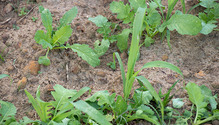
Serving as the foundation for all agricultural endeavors, soil requires our management and protection to maintain functioning ecological systems.
“As part of managing for a healthy soil, cover crops are commonly utilized in agronomic systems to meet several goals, such as keeping the ground covered and adding biological diversity,” says Jeff Goodwin, pasture and range consultant for The Samuel Roberts Noble Foundation.
The Natural Resources Conservation Service (NRCS) defines cover crops as “grasses, legumes, and forbs planted for seasonal vegetative cover.” The purposes for planting cover crops as described by the NRCS are to:
· Reduce wind and water erosion
· Maintain or improve soil health and organic matter content
· Reduce water quality degradation by utilizing excessive soil nutrients
· Suppress excess weed pressures and break pest cycles
· Improve soil moisture use efficiency
· Minimize soil compaction
However, livestock grazing isn’t listed as one of the purposes for a cover crop. Goodwin notes that many producers are utilizing mixed-species cover crops in cropland and pasture systems to improve diversity, organic matter, and soil microbiological function. Grazing livestock on the crops adds the benefits of animal impact and distribution of manure.
“Once livestock grazing is introduced, these are no longer traditional cover crops with the sole purpose of improving the soil,” Goodwin states in the Noble Foundation’s newsletter, Ag News and Views. Instead, they are now mixed-species dual-purpose forage crops.
Mixed-species forage crops have similar purposes as traditional cover crops, but they also provide a forage source for grazing livestock. When grazing, leave proper amounts of residue and avoid complete graze out in order to gain the soil health benefits.
Depending on rainfall and region of the country, various utilization rates can be implemented. A rule of thumb is to determine the amount of production needed to meet your residue goals, and then graze any additional production.
If cover crops planted with the goal of adding organic matter to the soil are harvested for hay or cut for silage, this goal will not be fulfilled because organic matter will be lost.
“Grazing mixed-species forage crops can be very useful and adds flexibility in beef production systems,” Goodwin says. But he believes the focus should be on balancing livestock forage demand with addressing the soil health concern that prompted planting the cover crop.

Sydney Sleep was the 2016 Hay & Forage Grower summer editorial intern and is a junior at South Dakota University.

